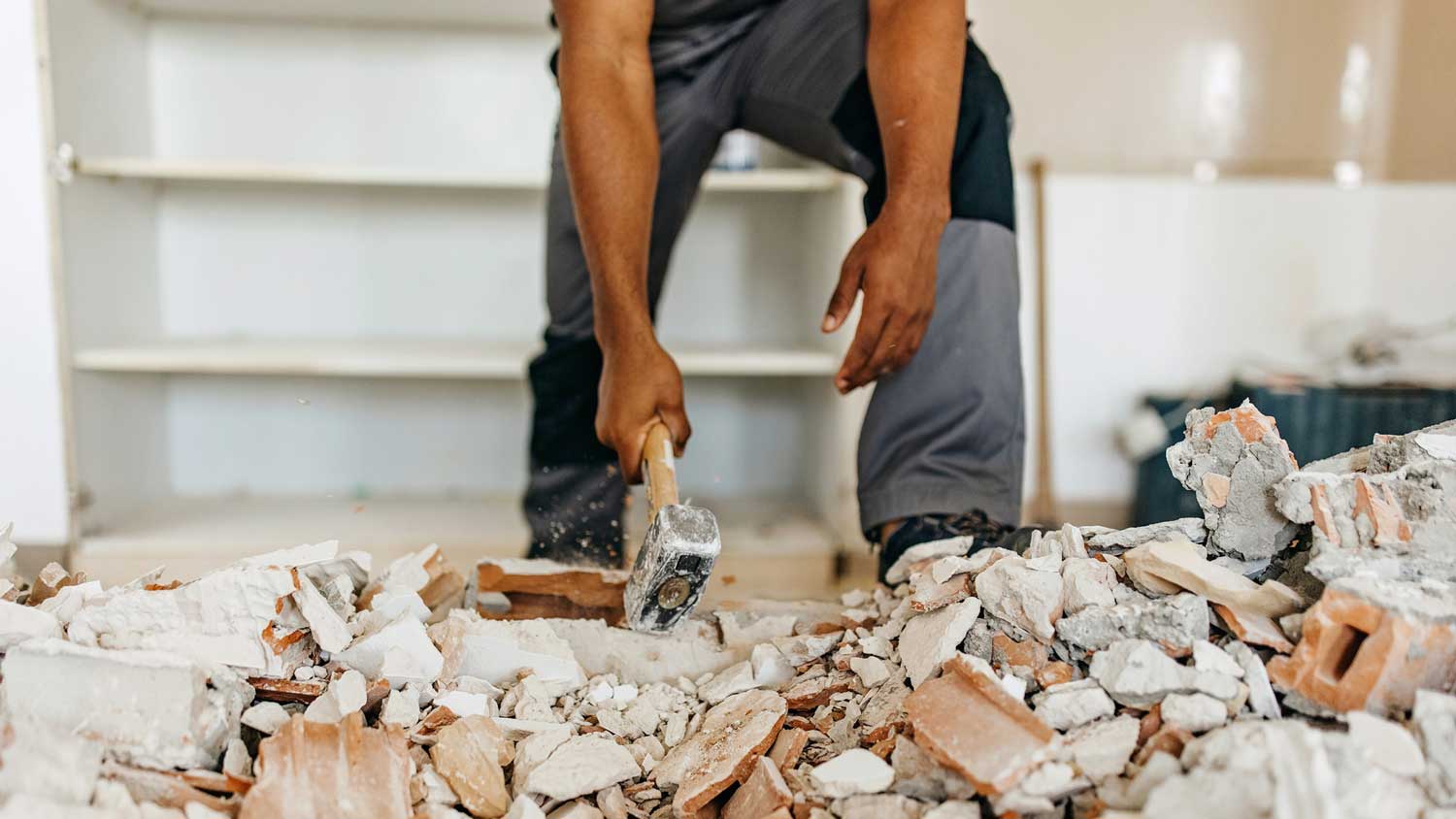
Fire damage restoration costs vary widely based on the extent of the damage. Learn how to assess your home and estimate your total after a fire.
Fire damage restoration involves swift coordination of pros across multiple industries


Fire damage restoration consists of three parts: assessment, cleanup, and restoration.
The average cost for fire restoration is $27,200, or between $4 and $7 per square foot.
While minor fire damage is technically DIYable, hiring a pro is best, as it’s dangerous work, and missing structural issues is an easy mistake to make.
The aftermath of a house fire can leave you feeling helpless and lost, but understanding the fire damage restoration can give you hope that a sense of normalcy is on the horizon. In this guide, we’ll explain the process from start to finish so you know what to expect and how long you’ll have to wait before you’re back in your home.

Fire damage restoration is a disaster restoration or recovery service for homeowners and business owners after a fire. It takes place after the fire is put out by firefighters, and it involves assessing the damage, cleaning up water or chemicals used for extinguishing, removing soot and debris, and bringing the home back to its “pre-loss condition.”
Common tasks include boarding up the property, scrubbing off soot, removing damaged materials and smoke odors, mitigating any disturbed hazards (like asbestos or mold), and rebuilding the home. Because it coordinates work from various industries and professions, the fire damage restoration process involves considerable logistics, labor, skills, and effort.
Entering a home after a fire is dangerous, no matter one’s experience. That’s why set standards are in place to keep people and properties safe. Most companies follow the BSR/IICRC S740 Standard for Professional Restoration of Fire and Smoke Damaged Personal Items, which is a set of methods and principles for evaluating and restoring damaged personal property.
Your local fire damage restoration company will follow industry standards for removing toxic chemicals, dangerous components, and unsafe framing and systems to make sure your home is safe and clean when they’re done.
Before starting the fire damage restoration process, you can do a few things to help prepare yourself and your home to ensure a smooth transition back to normalcy.
Don’t enter your home: Never enter your home after a large fire because it’s very likely unsafe. There could be structural damage, but even if there isn’t, inhaling soot is hazardous. Only enter after you get an assessment from a restoration company (or at least the approval from the fire department).
Contact your insurance company: The faster you contact your insurance provider, the better. They can provide detailed information about the process and helpful water damage insurance claim tips that can make sure you get the most bang for your buck.
Get a copy of the fire report: Your insurance company will need a copy of the fire report to process any claims. Request it from your local fire department to ensure you have it on hand when they need it.
Record any damaged items: If it’s deemed safe to enter your home, start making a list of what items were damaged. If you can’t get into your home yet, you can still start creating a list of big-ticket items that, if damaged, will cost a lot to replace. This will give you a leg up during the claims process.
Hire a reputable restoration company: There are many restoration companies out there, but not all of them offer fast, reliable, and affordable services. Compare multiple providers, read reviews, and get quotes to find and hire a local fire restoration company that best fits your needs.

When the fire damage restoration team arrives, they’ll tackle three main steps to restore your home to its original condition: assessment, cleanup, and restoration. Each step requires a coordinated effort from multiple experts in some cases unless you hire a fire damage restoration specialist who can tackle everything.
Once emergency personnel determine your home is safe to enter, your fire damage expert will start assessing the damage. They’re looking for things to see the impact of the smoke and fire on the structural integrity of your home, how much water is leftover from the fire department, and how extensive the cleanup will be.
They’ll also look for other risk factors, like exposed wiring and weak floor spots, to ensure it's safe for all construction crews to enter.
Once they’re done, you can expect to receive a full scope of the work, including a timeline, estimated costs, and required tasks. For major fire damage, getting the actual estimate can take a few days, but pros will carry out the actual assessment within just a few hours in most cases so that you can move forward with the rest of the fire damage restoration process.
Before they go any further, the team will board over windows and doors, as necessary, and set up a temporary fence around your property to keep the property secure and prevent anyone from accessing it. This can also help keep water and pests out of the home.
One type of fire damage that many people forget to consider is the damage caused by the water or chemicals your firefighters use to extinguish the flames. Both will soak into building materials like carpeting, drywall, and wooden components.
To prevent further damage, the restorers must start the water damage cleanup process almost immediately. If your firefighters used water, your professionals may need to pump standing water out of the home, remove puddles with shop vacuums, and set up blower fans and dehumidifiers to keep the area dry. Mold can begin forming within 24 hours of water damage, so this part of the process can help reduce fire damage restoration costs by avoiding mold remediation and wood rot.
If any structures are too far gone to be salvaged or have too much water damage and are now considered dangerous, the pros will start to remove them. The demolition could just include removing carpets and cutting out drywall, but in severe cases, they may need to remove damaged framing and structural components before starting the buildback.
Crews will start working to remove any soot and clean smoke damage from your home's walls and other physical components. They’ll scrub walls and other affected materials and may make use of smoke remediation methods like ozone smoke removal to eliminate odors. Once it’s cleaned up, they’ll apply deodorizing agents to make sure the smell (which often penetrates deeper than the physical damage) is removed as well.
The goal of restoration is to bring the home back to its “pre-loss” condition. So, depending on the damage, this could be as easy as painting walls and replacing flooring or as complicated as rebuilding an entire area of the home. In some cases, this could take days, while in others, it could take weeks or even months, depending on the extent of the damage and how long it takes your insurance company to approve the work.
You should always leave fire restoration to the professionals. Attempting it yourself is dangerous and could lead to much more damage—both to your property and yourself. A professional can assess and mitigate any risks more efficiently, including hidden damage, to give you and your family greater peace of mind. Working in a fire-damaged home can also be dangerous, as breathing in soot and chemicals from extinguishers is hazardous.
On average, fire damage restoration costs $27,200, and most homeowners pay between $3,100 and $51,200, depending on the type and extent of the damage and the size of the home. Class D fires (ones involving combustible metals like aluminum) will cost more to restore than Class A fires (ones involving ordinary materials like wood and plastic.) But usually, the cost is between $4 and $7 per square foot.
Sometimes, house fires are unavoidable, depending on the cause of the fire. In those instances, hiring professionals to carry out restoration is your best course of action. However, there are many things you can do to help prevent house fires in the first place, and most of these are DIYable.
Never leave flames or cooking appliances unattended. Stay near ovens, stovetops, and microwaves when in use. Don’t leave the room while you’re cooking, and never leave appliances running when you leave the house.
Avoid using space heaters or use them with caution. Rely on your central heating system if possible. If you must use space heaters, use them on hard flooring and leave 3 feet of space on all sides during use. Turn them off when you go to sleep, and never use them near bedding or drapes.
Use wood-burning stoves and fireplaces carefully. If you have a wood-burning stove or fireplace, always close the doors to prevent embers from flying out. Never leave fires going overnight or when you leave the home.
Test your smoke alarms monthly. Test them monthly and replace the batteries annually unless you have hard-wired smoke detectors.
Have fire extinguishers at the ready. Keep extinguishers in areas where fires are most likely, like garages and kitchens. Know where they are and how to use them, and be sure to replace them when they expire.
Store flammable materials properly. Store flammable materials away from heat sources, in proper plastic containers, and in well-ventilated areas.
Use electrical outlets properly. Don’t overload outlets with power strips, and never plug anything in that has frayed wires.
Clean your chimney once a year. Have a professional clean out your chimney once per year. Keep in mind that you’ll need this even if you don’t have a fireplace, as your boiler or furnace likely vents through a chimney.
Hire a pro to clean your dryer vent annually. Always remove dryer lint from the lint catcher before each load, and then hire a pro to remove lint from the dryer vent once per year.
From average costs to expert advice, get all the answers you need to get your job done.

Fire damage restoration costs vary widely based on the extent of the damage. Learn how to assess your home and estimate your total after a fire.

Fire hydrant costs might not be an expense you think about day-to-day, but they’re important to consider for the safety of your home.

Water damage restoration costs depend on the severity of the problem, the type of water, and the length of time the damage has been occurring.

Learn how smoke can impact your home and health, and explore effective strategies for cleaning and prevention

Not sure of the differences between water damage and flood damage? Our guide explains how these two types of similar-sounding damage are very different.

Water damage is classified by how much water there is and what materials are affected. Learn about the four classes of water damage and how to identify them.